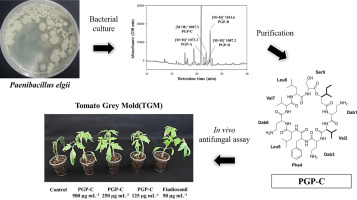当前位置:
X-MOL 学术
›
Pestic. Biochem. Phys.
›
论文详情
Our official English website, www.x-mol.net, welcomes your feedback! (Note: you will need to create a separate account there.)
Structure and antifungal activity of pelgipeptins from Paenibacillus elgii against phytopathogenic fungi
Pesticide Biochemistry and Physiology ( IF 4.7 ) Pub Date : 2020-02-01 , DOI: 10.1016/j.pestbp.2019.11.009 Jueun Kim 1 , Khanh Duy Le 2 , Nan Hee Yu 2 , Jae Il Kim 3 , Jin-Cheol Kim 2 , Chul Won Lee 1
Pesticide Biochemistry and Physiology ( IF 4.7 ) Pub Date : 2020-02-01 , DOI: 10.1016/j.pestbp.2019.11.009 Jueun Kim 1 , Khanh Duy Le 2 , Nan Hee Yu 2 , Jae Il Kim 3 , Jin-Cheol Kim 2 , Chul Won Lee 1
Affiliation

|
Paenibacillus elgii JCK1400 shows strong antifungal activity against various plant pathogenic fungi in vitro, but little is known about its mode of action. Four antifungal lipopeptides were isolated from P. elgii JCK1400 using bioassay-directed fractionation. Their chemical structures were determined to be pelgipeptins (PGPs) using electrospray ionization tandem mass spectrometry (ESI-MS/MS) and nuclear magnetic resonance (NMR) spectroscopy. Among the four lipopeptides, PGP-C showed the strongest mycelial growth inhibitory activity against several plant pathogenic fungi-with minimum inhibitory concentration (MIC) values ranging from 4 to 32 μg mL-1-followed by PGP-D, -A, and -B. In pot experiments, PGP-C also effectively suppressed the development of important fungal diseases in crops. In particular, PGP-C was effective in controlling tomato grey mold and wheat leaf rust, with control values of 91% and 73%, respectively, at a concentration of 125 μg mL-1. The fermentation broth of the antagonistic bacterium reduced the development of creeping bentgrass dollar spot and Kentucky bluegrass brown patch in a dose-dependent manner. However, our study on the effect of PGP-C on the fungal cell membrane-using microscopic observation with propidium iodide (PI) fluorescence-indicated that PGP-C does not target the fungal cell walls, but instead targets the cell membranes. This is the first study to report the in vitro and in vivo antifungal activity of PGP-C against various plant pathogenic fungi. Our results suggest that P. elgii JCK1400, which produces PGPs, could serve as a potential biocontrol agent for plant diseases caused by various fungi.
中文翻译:

来自类芽孢杆菌 elgii 的 pelgipeptins 的结构和抗植物病原真菌的抗真菌活性
Paenibacillus elgii JCK1400 在体外对多种植物病原真菌表现出很强的抗真菌活性,但对其作用方式知之甚少。四种抗真菌脂肽从 P. elgii JCK1400 中使用生物测定定向分级分离。使用电喷雾电离串联质谱法 (ESI-MS/MS) 和核磁共振 (NMR) 光谱法确定它们的化学结构为 pelgieptins (PGPs)。在四种脂肽中,PGP-C对几种植物病原真菌表现出最强的菌丝生长抑制活性——最小抑制浓度(MIC)值范围为4至32 μg mL-1——其次是PGP-D、-A和- B. 在盆栽试验中,PGP-C还有效抑制了作物重要真菌病害的发展。特别是,PGP-C 对番茄灰霉病和小麦叶锈病的防治效果显着,在 125 μg mL-1 的浓度下,防治值分别为 91% 和 73%。拮抗细菌的发酵液以剂量依赖性方式减少匍匐翦股颖斑病和肯塔基兰草棕斑病的发展。然而,我们对 PGP-C 对真菌细胞膜影响的研究——使用碘化丙啶 (PI) 荧光显微镜观察——表明 PGP-C 不靶向真菌细胞壁,而是靶向细胞膜。这是第一项报告 PGP-C 对各种植物病原真菌的体外和体内抗真菌活性的研究。我们的结果表明,产生 PGPs 的 P. elgii JCK1400 可以作为各种真菌引起的植物病害的潜在生物防治剂。
更新日期:2020-02-01
中文翻译:

来自类芽孢杆菌 elgii 的 pelgipeptins 的结构和抗植物病原真菌的抗真菌活性
Paenibacillus elgii JCK1400 在体外对多种植物病原真菌表现出很强的抗真菌活性,但对其作用方式知之甚少。四种抗真菌脂肽从 P. elgii JCK1400 中使用生物测定定向分级分离。使用电喷雾电离串联质谱法 (ESI-MS/MS) 和核磁共振 (NMR) 光谱法确定它们的化学结构为 pelgieptins (PGPs)。在四种脂肽中,PGP-C对几种植物病原真菌表现出最强的菌丝生长抑制活性——最小抑制浓度(MIC)值范围为4至32 μg mL-1——其次是PGP-D、-A和- B. 在盆栽试验中,PGP-C还有效抑制了作物重要真菌病害的发展。特别是,PGP-C 对番茄灰霉病和小麦叶锈病的防治效果显着,在 125 μg mL-1 的浓度下,防治值分别为 91% 和 73%。拮抗细菌的发酵液以剂量依赖性方式减少匍匐翦股颖斑病和肯塔基兰草棕斑病的发展。然而,我们对 PGP-C 对真菌细胞膜影响的研究——使用碘化丙啶 (PI) 荧光显微镜观察——表明 PGP-C 不靶向真菌细胞壁,而是靶向细胞膜。这是第一项报告 PGP-C 对各种植物病原真菌的体外和体内抗真菌活性的研究。我们的结果表明,产生 PGPs 的 P. elgii JCK1400 可以作为各种真菌引起的植物病害的潜在生物防治剂。


























 京公网安备 11010802027423号
京公网安备 11010802027423号